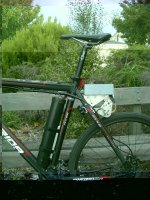Kepler
10 MW
EVTodd said:Just use the brake to create a load. That's what I did when I made my video (which reminds me, I never did repost that video)..
Too easy. Thanks for that.
EVTodd said:I think what most people don't understand is that with a system like this you rarely have the motor fully engaged. When I go full throttle the motor slides back into the tire and then backs off depending on the load (even at full throttle). If I'm going up a very steep hill then yes, it is fully engaged but 95% of the time it doesn't have much pressure on the tire at all.
I think my setup tends to hit the stopper at at around 50% throttle but its hard to tell when riding.
I did some more testing last night. Put through 2 more packs. The drive worked perfectly with the engagement and disengagement operating exactly as I hoped. The actual acceleration and speed is actually far better then I expected also with the bike hitting 60 kph on a few runs. Motor and ESC temps are also very acceptable. It sure isnt stealth though. Sounds like the bike has a turbine fitted especially at full throttle. Very cool stuff.


